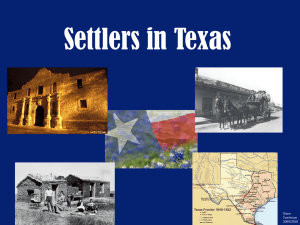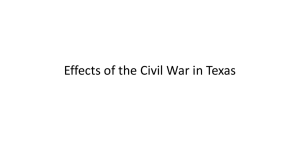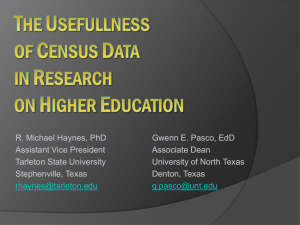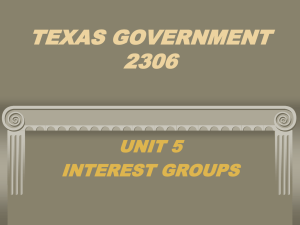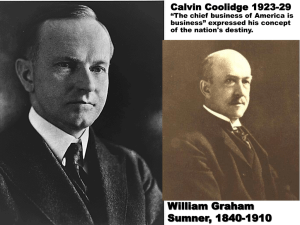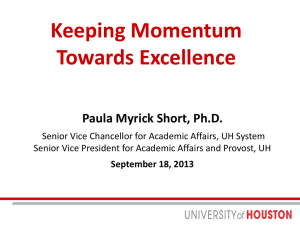Unit 13 Section 2 Notes
advertisement
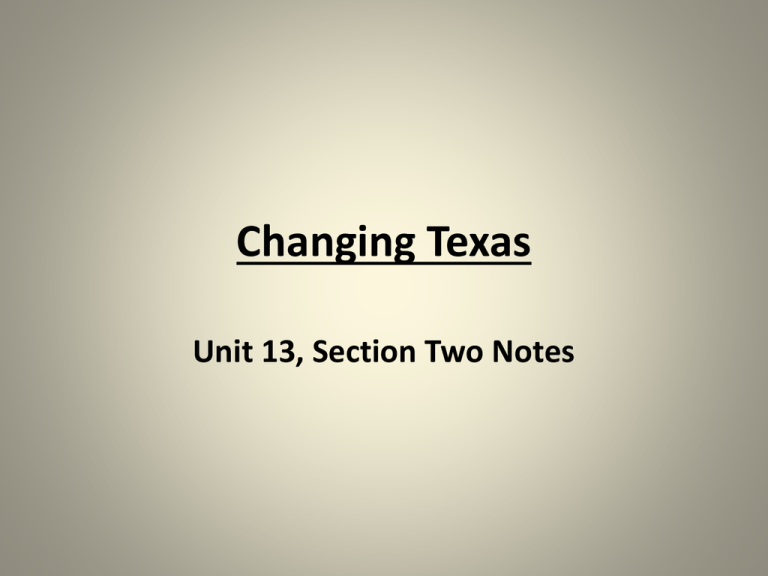
Changing Texas Unit 13, Section Two Notes Texas is Growing • Texas is growing in almost every way, with both the economy and population. More and more people come to Texas to live every year, and these population changes lead to issues that Texans struggle with and problems that need to be solved. Immigration to Texas Immigration to Texas has been debated in our state for many years now. For the most part, Texans have pushed for more strict laws regarding immigration for the following reasons: • Some illegal immigrants use government services, like schools, without paying taxes. • When a child of an immigrant is born in the U.S., they become a citizen while their parents are not. Because of such problems, laws have been passed to make it more difficult for illegal immigrants to get jobs in Texas. Some people have suggested building a wall between the Texas and Mexico border. Texas Education • In the state of Texas, property taxes are used to fund public education. • Every political session, there is a high demand by citizens and law makers to reform, or change, how we pay for education. • In some places, property taxes are very high, but this only affects those people who own property. • Some say that Texas should instead use an income tax to fund education. Texas Transportation As the population of Texas grows, transportation throughout the state becomes a bigger issue. • Highways, roads, and bridges are maintained by city, county, and state funds. Sometimes, money from the national government is used to fix transportation problems or create new roads. • Toll roads are sometimes built to help fund future transportation costs. As you drive on the road, you pay a fee. • New roads decrease congestion and traffic, but also lead to increased pollution as more room is made for more cars. Migration • Not only are their more people moving to Texas, but there are also lots of Texans who are moving from the country to the city. • This increased urbanization leads to bigger cities, which can cause problems related to transportation, education, and even natural resources, like water! • Cities seem to have more problems because of this, but small towns also have to deal with such problems, like water shortages after a long drought. http://www.cityofllano.com/CITY/stage1.pdf Regions of Texas Because of immigration and migration changes, the regions of Texas are also changing. Coastal Plains • Most of the major cities of Texas are located in the Coastal Plains region. Because of the cities, there are many large highways systems throughout this part of the state. • Major industries in this region include: timber, agriculture, oil and gas, technology, education, and tourism. • Tourism – this is a large area for tourism because of the cities and coastline within the region. Central Plains • This region is more rural compared to the Coastal Plains. • Major industries in the region include: agriculture, manufacturing, and military defense. Great Plains • The Great Plains is even more rural than the Central Plains! • Industries in this region include: agriculture and ranching, oil and gas, and new sources of energy, like wind farms. • For ranching and farming to be successful in this region, irrigation is very needed. Mountain and Basins • The Mountains and Basins region is the most rural region of Texas. • Industries of this region include: cattle, sheep, and goat ranching. • People go to the Mountains and Basins region to visit Big Bend National Park (or just to drive through to get to other states!). Adapting to the Texas Environment Texans have made many modifications to the Texas ecosystems in order to make living in Texas more comfortable and enjoyable. Still, these changes have consequences. • Texans have built dams on rivers in order to use the rivers for electricity and recreation. – This can cause pollution on the rivers, and some of the rivers are drying up. – It can provide Texans with more stable water supplies in some areas. Adaptations Continued… • Texans on the Great Plains have irrigated the land in order to grow cotton and other crops. – More crops are grown. – The aquifers underground are drying up from overuse and drought. Poses the question of who really owns water! • Texans have drilled for oil in and around the Gulf of Mexico. – This has lead to economic growth for the oil and gas industry and given jobs to Texans. – Drilling has also led to the pollution of beaches and wildlife. Alternative Energy in Texas In recent years, Texas has attempted to follow the rest of the United States in trying to create and utilize different types of alternative energy. Examples of alternative energy sources include solar and wind energy. • The state legislature has passed laws to help encourage the growth of these types of energy through funding and tax breaks. • In the beginning, alternative energy is costly to create, but we anticipate that it will become cheaper over time. • People against alternative energy feel that it could hurt Texas jobs or wildlife. Make Up of Texas Population • http://quickfacts.census.gov/qfd/states/48000 .html • Based on the current census numbers, demographers are able to predict the growth rate, or annual rate, at which the population is expected to grow. Growth Rate Estimates Based on Race • Anglo – 2000: 11,074,716 – 2040: 12,225,486 • Black – 2000: 2,421,653 – 2040: 3,995,349 • Hispanic – 2000: 6,669,667 – 2040: 29,926,210 • Other – 2000: 685,785 – 2040: 4,435,916 Who is coming to Texas? Many different immigrant groups came to Texas for varying reasons during the 20th Century, including for job and education opportunities. • Eastern Europeans: came because of religious persecution and economic depression in their own countries, moved to urban areas. • Latin Americans: came because of economic reasons, moved to urban and rural areas. • Vietnamese: many came as refugees from the Vietnam War, moved to urban areas and along the Texas coast. • Arabs: came for oil jobs or because of conflict in the Middle East, moved to urban areas. Diversity and Culture Because of Texas’ diverse background and population, our culture is different in many ways. As people from other countries attempt to maintain their home religions, traditions, and cultures, these things seep into Texas way of life. Spanish culture is probably the most predominant throughout the state. • Examples: names of cities, rivers, etc…, foods, religion, arts, and the English vocabulary. Arts Contributors in Texas There are many famous people from all different backgrounds who are important to the Texas arts! We will now look at some examples!!! Roy Bedichek • As a lifelong outdoorsman and animal lover, Bedichek wrote Adventures with a Texas Naturalist in 1947. • He is still remembered as an entertaining folklorist and storyteller. • His family lived in Falls County and helped to found the schools in Eddy, Texas! • At one point, he helped run the UIL organization. • He died in 1959. Diane Gonzales Bertrand • Diane is a Mexican-American author of children’s and young adult books which focus on Mexican-American characters. • Her most famous children’s book is Family, Familia. • She currently lives in San Antonio, Texas, where she works at St. Mary’s University as a professor. J. Frank Dobie • Dobie was a Texas writer who wrote about Black, Anglo, and Hispanic cowboys, as well as Native American, Spanish-American, African- American, and Mexican culture. • His books focus on the myths and legends of Texas. • He is best known for The Longhorns, The Mustangs, and A Vaquero of the Brush Country. • He lived all over Texas and was very important to the movement to keep the longhorns from extinction. Scott Joplin • Joplin was an African-American Texan who was famous for establishing ragtime music in Texas. • He lived in Texarkana, Texas. • He wrote more than 500 pieces of music, including a ballet and two operas! • Maple Leaf Rag http://www.youtube.com/watch?v=pMAtL7n_ -rc Elisabet Ney • Ney was a German-born sculptor and artist that immigrated to Texas at the age of 39 with her husband. • Some of her most famous sculptures are of Sam Houston and Stephen F. Austin, and those and others are erected at the state and national capitol buildings. • There is a museum named for her in Austin, Texas. • She and her husband helped to establish universities in Texas, along with the Texas Fine Arts Association. Other Important People… • Amado Pena Jr. – an artist who painted Native American tribute paintings • Walter Prescott Webb – well respected historian who wrote The Texas Rangers and The Great Plains • Horton Foote – American playwright and screenwriter, wrote the screenplay for To Kill a Mockingbird

